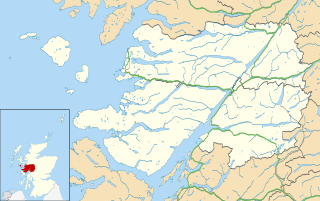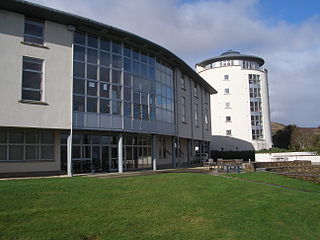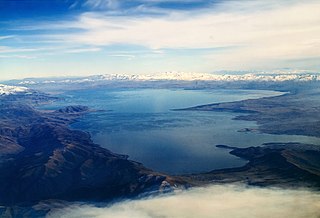
Glencoe or Glencoe Village is the main settlement in Glen Coe in the Lochaber area of the Scottish Highlands. It lies at the north-west end of the glen, on the southern bank of the River Coe where it enters Loch Leven.

Clan Donnachaidh, also known as Clan Robertson, is a Scottish clan.

Loch Leven is a sea loch located on the west coast of Scotland. It is spelled Loch Lyon in Timothy Pont's map of the area and is pronounced Li' un. The local Gaelic pronunciation is Lee' oon
The Columba Project, formerly known as the Columba Initiative is a program for Gaelic speakers in Scotland and Ireland to meet each other more often, and in so doing to learn more of the language, heritage and lifestyles of one another. It was named after Colm Cille, whose monasteries shaped and spanned the Gaelic world of Ireland and Scotland.
In Irish mythological history Mug Nuadat son of Mug Neit, son of Derg, son of Dergthene, son of Enna Munchain, son of Loch Mor, son of Muiredach Mucna, son of Eochaid Garb, son of Dui Dalta Dedad was a legendary, supposed King of Munster in the 2nd century AD. He was, according to later medieval tradition, a rival of the High King, Conn of the Hundred Battles, and for a time after the year 123 was the de facto ruler of the southern half of Ireland. Everything south of a line drawn between Galway Bay and Dublin was known as Leth Moga, and everything north of that line was Leth Cuinn.

Sabhal Mòr Ostaig is a public higher education college situated in the Sleat peninsula in the south of the Isle of Skye, with an associate campus at Bowmore on the island of Islay, Ionad Chaluim Chille Ìle. Sabhal Mòr is an independent Academic Partner in the federal University of the Highlands and Islands. Uniquely, its sole medium of instruction is Scottish Gaelic.

The Clan MacLellan is a Lowland Scottish clan. The clan does not currently have a chief therefore it is considered an Armigerous clan.
Ionad Chaluim Chille Ìle is a Gaelic medium college on the shores of Loch Indaal, on Islay, in Scotland. Named after Saint Columba, it was founded in 2002 as part of the University of the Highlands and Islands, and is in a partnership with Sabhal Mòr Ostaig (Skye).

Aonghas MacNeacail, nickname Aonghas dubh or Black Angus) is a contemporary writer in the Scottish Gaelic language.

The O'Donoghue of the Glens, Prince of Glenflesk, is the hereditary chieftain of his sept of the Kerry Eóganacht. In 1944, his father was one of the few Chiefs of the Name recognized by Edward MacLysaght, the first Chief Herald, as having a verifiable pedigree and entitled to use the title and receive courtesy recognition by the Irish State.
Eóganacht Locha Léin or Ui Caipre Luachra were a branch of the ruling Eoganachta of Munster. Their territory was in Iarmuman or West Munster. Luachair (Lúachra) is the old name of a large district on the borders of Co Cork, Kerry and Limerick. Cairbre of Sliobh Luachra was on the Cork-Kerry border; Éoganacht Locha Lein is around the Lakes of Killarney.
Cathal mac Áedo Flaind Chathrach was a King of Cashel in Munster from the Glendamnach sept of the Eoganachta. He was the son of Áed Fland Cathrach and grandson of Coirpre Cromm mac Crimthainn a previous king of Cashel. He succeeded to the throne on the death of Fíngen mac Áedo Duib in 618.
Fíngen mac Áedo Duib was a King of Munster from the Eóganacht Chaisil branch of the Eoganachta. He was the great-grandson of Feidlimid mac Óengusa, a previous king. He succeeded Amalgaid mac Éndai as king in 601.
Áed Bennán mac Crimthainn was a possible King of Munster from the Eóganacht Locha Léin branch of the Eoganachta. He was definitely king of West Munster or Iarmuman. He was the great grandson of Dauí Iarlaithe mac Maithni also a possible king of Munster from this branch
Maoilios Caimbeul is a Scottish writer of poetry, prose and children's literature. He writes in Scottish Gaelic.
The surnames MacGavin and McGavin are Scottish surnames, which are possibly variations of the surnames McGowan and MacGowan, which are Anglicised forms of the Scottish Gaelic MacGobhann and Irish Gaelic Mac Gabhann, meaning "son of the smith". When the surname MacGavin and McGavin originate from Glasgow and Moray, they can be represented in Scottish Gaelic as Mac a' Ghobhainn.
McEachern and MacEachern are Irish and Scottish surnames. The names are Anglicised forms of the Gaelic Mac Eichthigheirn, meaning "son of Eichthighearn". The personal name Eichthighearn is composed of two elements. The first is each, meaning "horse"; the second is tighearna, meaning "lord". The surnames MacEachern and McEachern can be represented in Scottish Gaelic by MacEachairn, and MacEacharna.
MacKechnie and McKechnie are Irish/Scottish surnames. They are Anglicised forms of the [[Irish/Scottish Gaelic MacEacharna, meaning "son of Eacharn". The Irish/Scottish Gaelic personal name Eacharn is composed of two elements. The first element, each, means "horse"; the second element, tighearna, means "lord". In Scotland, the Scottish Gaelic MacEacharna has usually been Anglicised as McEachern. The surnames MacKechnie and McKechnie can be represented in Scottish Gaelic by MacEachainn, and MacEacharna. The McKechnies are a Sept of the Macdonalds of Clanranald.
The history of Scottish Gaelic dictionaries goes back to the early 17th century. The high-point of Gaelic dictionary production was in the first half of the 19th century, as yet unrivalled even by modern developments in the late 20th and early 21st century. The majority of dictionaries published to date have been Gaelic to English dictionaries.

Roderick John MacLeod, Lord Minginish,, also known as Roddy John, is a Scottish solicitor and advocate. Since 2014 he has been Chairman of the Scottish Land Court and President of the Lands Tribunal for Scotland. He is the first Gaelic-speaking chair of the court.










